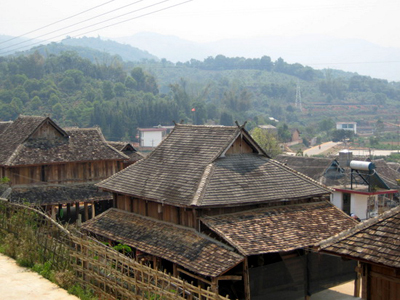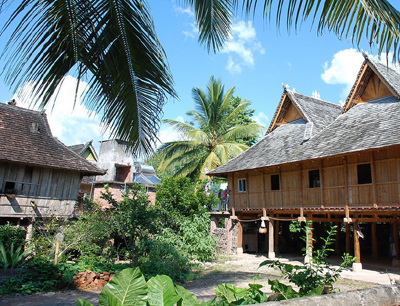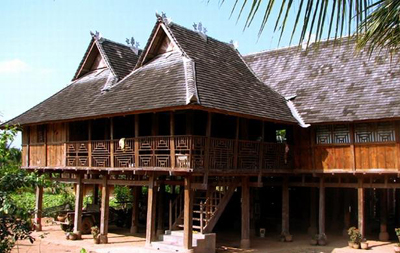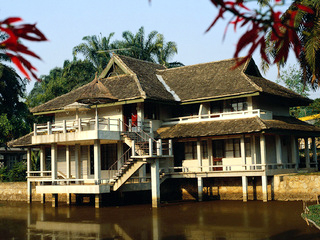The Dai ethnic group’s great wisdom: the bamboo house
Bamboo houses are the traditional housing of the Dai ethnic group in Xishuangbanna. This kind of building is primarily built of bamboo—the posts, girders, purlins, rafters, doors and walls are all made of bamboo. The Xishuangbanna area belongs to the tropical rainforest climate, and the rainfall is huge. For this reason, the roof of the bamboo house is specially designed to drain rain. The bamboo house is double-layered. This kind of design can prevent humidity. Therefore, the Dai people always live upstairs, and some sundries, livestock and poultry can be kept downstairs.
 |
The Dai ethnic group call their bamboo houses “Hen,” which is the shortened form of “Huanghen.” It is said that the word “Huanghen” came from the word “Hongheng,” because the two words have similar pronunciation. The word “Hongheng” means the bird phoenix spreads its wings and gets ready for flight. It is said that the primogenitor of the bamboo house was called Payasangmudi, who cudgeled his brain for designing the bamboo house at the beginning. One day, a phoenix suddenly flew to him and spread its wings to get ready for flight. Payasangmudi was deeply inspired by the phoenix. He built the high bamboo house with the slope style of four sides. He called the bamboo house “Hongheng,” which gradually evolved into “Huanghen” and “Hen.”
 |
The history and civilization of the Dai ethnic group is embodied by the bamboo house. Every part of a bamboo house represents a different meaning. The main support of a bamboo house is called a “falling stake,” which is the most sacred part of the bamboo house. People cannot lean on or put other things near the “falling stake,” because it is a symbol that can bless the bamboo house to be free of disaster. People always put some leaves under the stable when they build a new bamboo house, because it is said that this can make the house firmer. Besides the “falling stake,” there are also other stakes inside the bamboo house, which can represent male and female elements. That is interesting. The bulkier stake in the middle of the room represents male, while the shorter stake at the side of the room represents female.
 |
The traditional bamboo house can be divided into three types—Payasangtudi, Mahasati and Henmen. In the past, the bamboo house of the Dai ethnic group could be divided into two types according to social class: officer’s bamboo house and common people’s bamboo house.
The officer’s bamboo house is spacious and bright. It is built in the style of western “gothic construction,” in which the shape of the house is a square and the shape of roof is like a pyramid. The whole bamboo house is supported by 20 to 24 bulky stakes, which are built on the stone block. People always carve religious figures on the stakes. The interior’s shape is simple. The main room in the middle is the guest room. The wing-room is often divided into two or three rooms for the host’s wife and children. The guest room of the officer’s bamboo house is about thirty square meters, which can contain about twenty people.
Compared with the officer’s bamboo house, the common people’s bamboo house is quite narrow. The roof is covered with couch grass. The stake cannot be built on the stone block, and figures cannot be carved on the stake.
 |
The Dai ethnic group has the nice custom that “If a family builds a new house in the village, the other ones will come to give a hand.” The family who want to build a new house always blows ox horn, and then every one in the village will come to help. After the completion of a new house, a ceremony is always held to celebrate. People use this to reward villagers who came to help, and also to exercise. The ceremony is always held at high noon. After the exact time been decided, the elder who presides over the ceremony reads aloud his congratulations, and then announces that people can go upstairs in the new house. In the ceremony, the new house owner also invites male and female singers to sing The Song to Congratulate the New House together.
 |
















